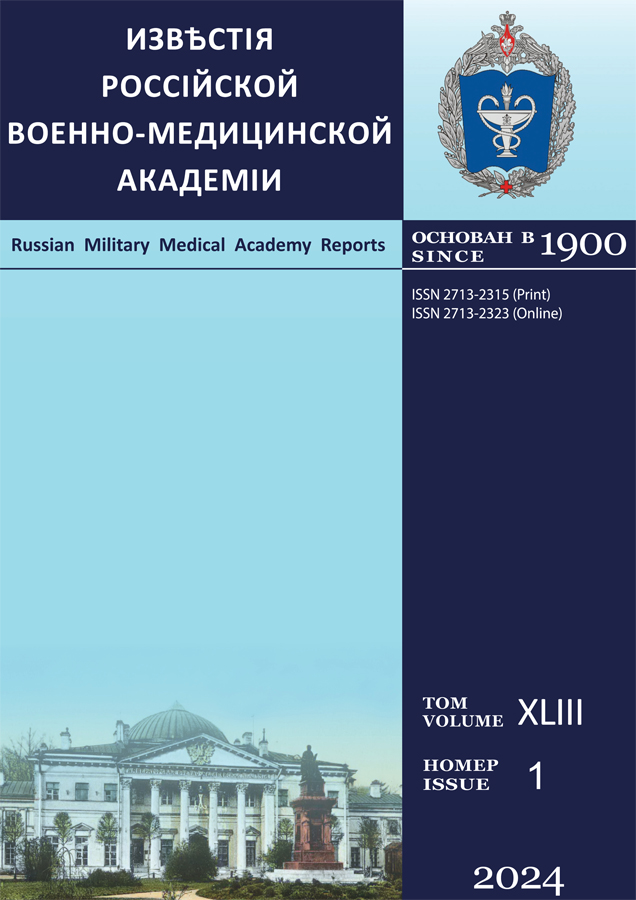Structural aspects of personality typology of patients suffering from cardiovascular pathology associated with type 2 diabetes mellitus
- 作者: Lavinskaia N.N.1, Starenchenko Y.L.1, Protasov O.V.1, Sarsengalieva A.K.1
-
隶属关系:
- Military Medical Academy
- 期: 卷 43, 编号 1 (2024)
- 页面: 49-57
- 栏目: Original articles
- URL: https://journal-vniispk.ru/RMMArep/article/view/257001
- DOI: https://doi.org/10.17816/rmmar604265
- ID: 257001
如何引用文章
全文:
详细
BACKGROUND: Diabetes mellitus started as a metabolic disorder, but finished as a vascular pathology, which determines the prognosis and outcomes of disease. The research of personality psychotypes of patients suffering from type 2 diabetes mellitus associated with cardiovascular pathology was undertaken in order to study one of the basic components of system-forming factor of the pathological nervous regulation system.
MATERIALS AND METHODS: 148 patients were examined (49 men, 99 women), divided into 2 groups: 1) patients with combined cardiovascular pathology and type 2 diabetes mellitus (monitoring group), 2) patients with cardiovascular pathology without type 2 diabetes mellitus (comparison group). Additional control group: 30 practically healthy volunteers. We conducted a questionnaire and a clarifying interview with profile patients undergoing a planned course of treatment in the therapeutic clinics. The domestic version of the psychological questionnaire test mini-mult AMPQ (Abbreviated Multifactorial Personality Questionnaire), which is an abbreviated form of MMPI, as well as “M. Lusher Color Selection Method” were used. The Nickstormsoftware computer software package “Oskord” (version 1.2) was used for statistical processing of the results.
RESULTS: It was found: there are three main psychotypes — asteno-neurotic, epileptoid-exitable, hyperthymic — prevail in the total population of patients suffering from type 2 diabetes mellitus associated with cardiovascular pathology. The most favorable clinical situation is observed in patients with hyperthymic personality type, what demonstrates the systemic level influence of the psychotype. The definition of the personality structure implements a personalized approach to the patient, because it allows you to take into account the characteristics of each psychotype.
CONCLUSION: Psychical factors affect the treatment of diabetes and concomitant pathology to the same extent as the treatment itself can affect the psychic state. Such a psychophysiological nature of interaction determines the modeling, possibly organizing role of psychotype components in the work of central link of the nervous regulation pathological system — the basis of the cardiovascular pathology associated with type 2 diabetes mellitus pathogenesis, which requires further scrupulous research, analysis and generalization.
作者简介
Natalia Lavinskaia
Military Medical Academy
编辑信件的主要联系方式.
Email: lavinskaya_nat@mail.ru
ORCID iD: 0000-0002-3505-5875
MD, Cand. Sci. (Medicine), Associate Professor
俄罗斯联邦, Saint PetersburgYuri Starenchenko
Military Medical Academy
Email: star113@yandex.ru
Cand. Sci. (History), Associate Professor
俄罗斯联邦, Saint PetersburgOleg Protasov
Military Medical Academy
Email: izvestiavmeda@mail.ru
ORCID iD: 0000-0003-4003-4881
MD, Cand. Sci. (Medicine)
俄罗斯联邦, Saint PetersburgAinagul’ Sarsengalieva
Military Medical Academy
Email: gys22@list.ru
MD, Cand. Sci. (Medicine)
俄罗斯联邦, Saint Petersburg参考
- Sergienko IV, Ansheles AA, Halimov YS, et al. Cardiological aspects of type 2 diabetes mellitus. Moscow: Pero Publ.; 2018. (In Russ.)
- Dedov II, Shestakova MV, Galstyan GR. Prevalence of diabetes mellitus in the Russian Federation: clinical and statistical analysis acсording to the Federal Register of Diabetes Mellitus. Diabetes Mellitus. 2017;(1):13–41. (In Russ.) doi: 10.14341/DM8664
- Levesque C. Therapeutic Lifestyle Changes for Diabetes Mellitus. Nurs Clin North Am. 2017;52(4):679–692. doi: 10.1016/j.cnur.2017.07.012
- Avogaro A, Fadini GP, Sesti G, et al. Continued efforts to translate diabetes cardiovascular outcome trials into clinical practice. Cardiovasc Diabetol. 2016;15(1):111–117. doi: 10.1186/s12933-016-0431-4
- Alexander F. Psychosomatic medicine. Moscow: GERRUS Publ.; 2000. (In Russ.)
- Benton PS. Mental aspects of diabetes mellitus. Moscow: Academiya Publ.; 2000. (In Russ.)
- Nefs G, Pouwer F, Dennollet J, Pop VJ. Psychological risk factors of micro- and macrovascular outcomes in primary care patients with type 2 diabetes: rationale and design of the DiaDDZoB Study. BMC Public Healht. 2010;7(5):414–421. doi: 10.1186/1471-2458-10-388
- Schram MT, Baan CA, Pouwer F. Depression and quality of life in patients with diabetes: a systematic review from the European depression in diabetes (EDID) research consortium. Curr Diabetes Rev. 2000;5(2):112–119. doi: 10.2174/157339909788166828
- Ogilvie MB, Harvey JI. Pioneering Lives From Ancient Times to Mid-20th Century. New York: Routledge; 2003. P. 383–387.
- Batarshev AV. Psychodiagnostics of borderline personality and behavior disoders. Moscow: Publishing House of the Institute of Psychotherapy; 2004. (In Russ.)
- Timofeev VI, Filimonenko YI. Colour test M.Lusher (standardized version). Methodological guidance. Saint Petersburg: GP “IMATON” Publishing House; 2001. (In Russ).
- Melnikov VI, Leontyev VG. Application of the modified Lusher test for the diagnosis of mental state of personality. Psychopedagogy in law enforcement agencies. 2001;2(16):112–114. (In Russ.)
- Denolet J, Schiffer AA, Speak V. A general propensity to psychological distress affects cardiovascular outcomes: evidence from research on the type D (distressed) personality profile. Circ Cardiovasc Qual Outcomes. 2010;3(5):546–557. doi: 10.1161/CIRCOUTCOMES.109.934406
- Chermyanin SV, Kustova EI, Kuznetsova ME, Lelyakova IA. Psychological features of patients with cardiological profile with personality type D. Bulletin of the Leningrad State University named after A.S. Pushkin. 2017;(2):43–55. (In Russ.)
补充文件







